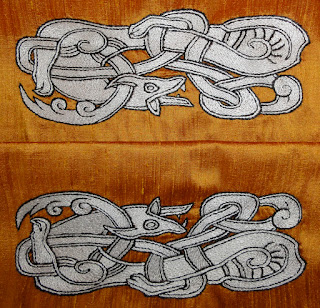In June I managed to get information about Gottfried’s upcoming Laurel elevation in October. I’m so happy that I had the time to make the gift I had planned for that eventuality. There is a portrait of Ottheinrich, Prince of Pfalz, painted by Barthel Beham in 1535. I knew that the gold embroidered collar that Ottheinrich is wearing in the portrait is one of Gottfried’s favourites. I wanted to embroider it for him.
Portrait of Ottheinrich, Prince of Pfalz, Barthel Beham, 1535
Portrait of Ottheinrich, Prince of Pfalz, Barthel Beham, 1535, detail
I studied the portrait in detail, to figure out what kind of embroidery it was. I also took a look at other late period German portraits with embroidered collars. I will write about them later. The gold is obviously couched, but there is clearly a pattern on it, that is a part of the gold surface. I looked at other existing embroideries and decided, that if one would paint a raised (3D) gold embroidery, it would propably look like the pattern in the portrait.
Raised gold embroidery on a chasuble, Italy 1500, in the collection of Bavarian National Museum on Munich.
(Picture by me, 2010)
So, I drafted a little simplified version of the collar pattern. I had to put it into two pieces to be able to fit it in my embroidery frame. Therefore there is a seam at the neck, but I didn’t think that was a big problem.
I had the gold thread ready, because I was working on another gold embroidery using the same thread. It is gold coloured metal strip wound on a cotton core (since I couldn’t afford the real gold on silk core). Now I know that the thread is a little too thick for this, but it works well enough. Next time I would take much thinner thread. I ordered freshwater pearls and gilded sequins to be added later.
The first task was to make the padded surface, which I stitched on the linen fabric with linen sewing thread.
Linen padding on linen ground.
(Picture by me, 2012)
Then started the most time consuming part of this work, couching in the gold. I had not done raised gold work before and learned quickly, that it is very important to keep the tension on the gold thread constant, not too loose and not too tight, othervice you’ll either get bumps on the surface or loose the crispiness of the edges of the raised pattern. The gold is surface couched in yellow filament silk. I timed how long does it take to make one row of the gold: approximately 15-25 minutes.
Gold embroidery in progress.
(Picture by me, 2012)
Gold embroidery done.
(Picture by me, 2012)
After the gold was done, I was already on the safe side. I had feared that I wouldn’t finish this piece in time, but in the end I had about three weeks left when I finished it. Sewing on the sequins and pearls was fairly fast job. Then I had to sew the two pieces together and add the gold cord to finish the edges and on top of the seam. The cord is made from the same gold thread by only twisting two threads together while sewing them on. After that I could add the sequins and a pearl on the neck over the seam to make it a continous pattern.
Now was the time for the last finishing touches. I added a piece of linen to cover the back of the embroidery and made two buttons by sewing 5 pearls tightly into a cluster. The buttons were sewn on the collar and the loops were made of the same gold thread twisted into a cord.
Tadah! All of 111 hours of work in one piece:
(Picture by me, 2012)
(Picture by me, 2012)
The three weeks I had before giving the collar to it’s recipient were spent in a haze. I had to go back to this piece to just touch it from time to time. It’s my baby! I hope to see it soon used on a shirt, which Gottfried will have to make himself.
What I learned from this project:
- It can be done, it just takes time.
- Embroidering a raised pattern isn’t as hard as it looks like, but I need to practice more of it.
- It’s good to keep track of how much time you have put into a piece of work.
- Finishing touches really make a huge difference.
And finally, I learned that it is possible not to want to give away something. This is the first time in my embroiderer life, that I have had it hard to give away something. At least I know that my baby got a good home and I have the possibility to see it every once in a while.
































